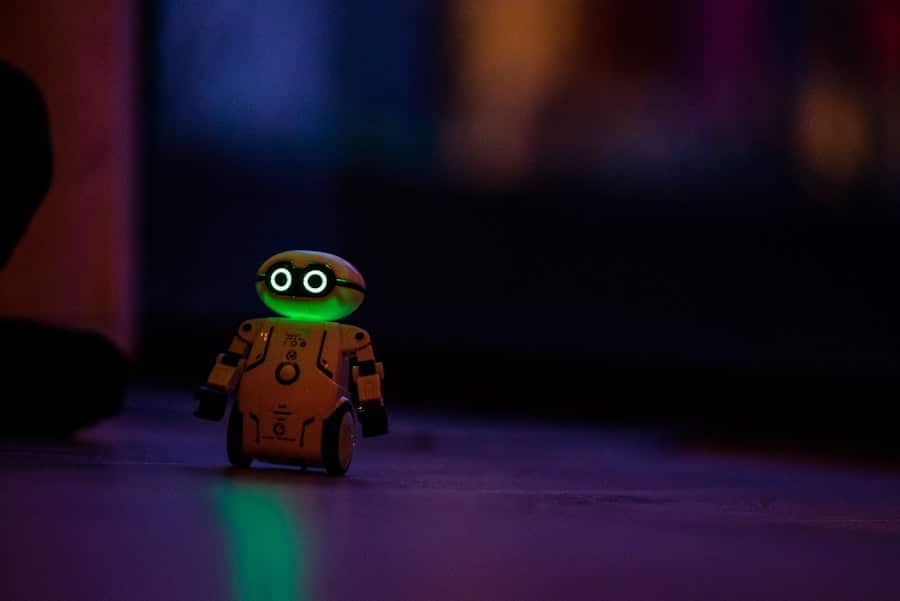The concept of smart home robots has evolved significantly over the past few decades, transitioning from mere science fiction fantasies to tangible realities that are increasingly becoming part of everyday life. These robots are designed to perform a variety of tasks within the home, ranging from mundane chores like vacuuming and lawn mowing to more complex functions such as security monitoring and personal assistance. The integration of artificial intelligence (AI), machine learning, and advanced sensors has enabled these robots to operate autonomously, adapt to their environments, and interact with human users in more intuitive ways.
As technology continues to advance, the potential for smart home robots expands, promising to enhance convenience, efficiency, and even safety in domestic settings. The rise of the Internet of Things (IoT) has further facilitated the development of interconnected devices that can communicate with one another, creating a cohesive ecosystem that enhances the functionality of smart home robots. This article delves into the current state of smart home robots, their technological advancements, potential applications, challenges they face, ethical considerations, and future trends that may shape their evolution.
Key Takeaways
- Smart home robots are designed to assist with various tasks and make daily life more convenient and efficient.
- Current smart home robots are capable of performing tasks such as cleaning, security monitoring, and entertainment.
- Advancements in technology have led to the development of smart home robots with improved AI, voice recognition, and autonomous navigation capabilities.
- Smart home robots have the potential to be used for tasks such as elder care, childcare, and remote monitoring of home environments.
- Challenges and limitations of smart home robots include cost, privacy concerns, and the need for further development in AI and robotics technology.
Current State of Smart Home Robots
The current landscape of smart home robots is diverse and rapidly evolving. A variety of products are available on the market today, each designed to address specific household needs. For instance, robotic vacuum cleaners like the Roomba have gained immense popularity due to their ability to autonomously navigate spaces, avoid obstacles, and efficiently clean floors without human intervention.
These devices utilize sophisticated algorithms and sensors to map out rooms, allowing them to optimize cleaning paths and ensure thorough coverage. In addition to cleaning robots, there are also lawn care robots such as the Husqvarna Automower, which can maintain lawns with minimal human oversight. These machines employ GPS technology and boundary wires to navigate gardens, cutting grass at predetermined heights while avoiding obstacles.
Furthermore, security robots equipped with cameras and motion sensors are becoming increasingly common. These devices can patrol homes, send alerts to homeowners when unusual activity is detected, and even provide live video feeds through mobile applications. The integration of voice assistants like Amazon Alexa or Google Assistant into these systems has further enhanced user interaction, allowing for voice commands and seamless control over multiple devices.
Advancements in Smart Home Robot Technology

Recent advancements in smart home robot technology have significantly improved their capabilities and usability. One notable development is the enhancement of AI algorithms that enable robots to learn from their environments and user preferences. For example, many modern robotic vacuums can now recognize different types of flooring and adjust their cleaning modes accordingly.
This adaptability not only improves cleaning efficiency but also extends the lifespan of the device by preventing unnecessary wear on various surfaces.
Lidar (Light Detection and Ranging) sensors are increasingly being used in smart home robots to create detailed maps of their surroundings.
This technology enables robots to navigate complex environments with greater accuracy, avoiding furniture and other obstacles while ensuring comprehensive coverage of the area. Additionally, improvements in battery technology have led to longer operational times and faster charging capabilities, allowing robots to complete tasks more efficiently without frequent interruptions.
Potential Applications for Smart Home Robots
The potential applications for smart home robots extend far beyond simple cleaning tasks. In the realm of elder care, for instance, robots can assist seniors with daily activities such as medication reminders, mobility support, and companionship. Robots like ElliQ are designed specifically for older adults, providing social interaction through conversation while also offering reminders for important tasks.
This application not only enhances the quality of life for seniors but also alleviates some of the burdens on caregivers. In addition to elder care, smart home robots can play a significant role in home security. Advanced surveillance robots equipped with facial recognition technology can monitor properties in real-time, alerting homeowners to potential intrusions or unusual activity.
These systems can be integrated with existing security measures such as alarms and smart locks, creating a comprehensive security network that enhances overall safety. Furthermore, smart home robots can assist in energy management by monitoring energy consumption patterns and suggesting optimizations for reducing utility costs.
Challenges and Limitations of Smart Home Robots
Despite the promising advancements in smart home robot technology, several challenges and limitations persist that hinder widespread adoption. One significant issue is the high cost associated with many smart home robots. While prices have decreased over time, high-end models with advanced features remain out of reach for many consumers.
This financial barrier can limit access to the benefits these technologies offer, particularly for lower-income households. Another challenge lies in the complexity of integration within existing home ecosystems. Many smart home devices operate on different platforms or require specific applications for control.
This fragmentation can lead to compatibility issues that frustrate users who wish to create a seamless smart home experience. Additionally, while many robots are designed to operate autonomously, they still require occasional human intervention for maintenance or troubleshooting. This reliance on user involvement can detract from the convenience that these devices are meant to provide.
Ethical and Privacy Considerations

Data Privacy and Security
Many smart home robots rely on cameras and microphones to function effectively, which can lead to potential breaches of privacy if not properly managed. Users must be aware of what data is being collected and how it is being used by manufacturers.
The Impact of Automation on Employment
There is an ethical dimension regarding the potential displacement of human jobs due to automation. As smart home robots take over tasks traditionally performed by humans—such as cleaning or caregiving—there is a growing concern about the implications for employment in these sectors.
Enhancing Productivity or Displacing Humans?
While proponents argue that these technologies can enhance productivity and free up time for more meaningful activities, critics caution against the societal impacts of widespread automation.
Future Trends in Smart Home Robots
Looking ahead, several trends are likely to shape the future of smart home robots. One significant trend is the increasing integration of AI and machine learning capabilities into these devices. As algorithms become more sophisticated, robots will be able to learn from user behavior more effectively, leading to personalized experiences that cater specifically to individual preferences and needs.
This level of customization could enhance user satisfaction and drive greater adoption rates. Another trend is the expansion of collaborative robotics within homes. Future smart home robots may not only operate independently but also work alongside humans in a more integrated manner.
For example, a robot could assist a person in cooking by providing step-by-step instructions while simultaneously preparing ingredients or cleaning up spills. This collaborative approach could redefine how household tasks are performed, making them more efficient and enjoyable. Additionally, as sustainability becomes an increasingly pressing global issue, future smart home robots may incorporate eco-friendly technologies that promote energy efficiency and waste reduction.
For instance, robots could be designed to optimize energy consumption by learning usage patterns and suggesting adjustments that minimize environmental impact.
The Promise of Smart Home Robots
The promise of smart home robots lies in their potential to transform everyday living by enhancing convenience, efficiency, and safety within our homes. As technology continues to advance at a rapid pace, these devices are becoming more capable and versatile than ever before. From cleaning floors to providing companionship for seniors or enhancing home security systems, the applications for smart home robots are vast and varied.
However, as we embrace this technological revolution, it is essential to address the challenges and ethical considerations that accompany it. By fostering a dialogue around privacy concerns and the implications of automation on employment, society can work towards a future where smart home robots enhance our lives without compromising our values or well-being. As we look ahead, it is clear that smart home robots will play an increasingly integral role in shaping our domestic environments and improving our quality of life.
If you are interested in learning more about the latest technology trends, you may want to check out TrustedReviews. This website offers expert reviews of the newest gadgets and devices, including smart home robots for housekeeping and assistance. Additionally, if you are looking for a versatile device that can help you stay organized and productive, you may want to explore the features of the Samsung Notebook 9 Pro.
Check out this article to discover some top options on the market.
FAQs
What are smart home robots for housekeeping and assistance?
Smart home robots for housekeeping and assistance are robotic devices designed to perform various tasks within the home, such as cleaning, organizing, and providing assistance to household members. These robots are equipped with advanced technologies such as artificial intelligence, machine learning, and sensors to navigate and perform their tasks efficiently.
What tasks can smart home robots perform?
Smart home robots can perform a wide range of tasks, including vacuuming and mopping floors, cleaning windows, organizing and tidying up spaces, monitoring home security, providing reminders and assistance to household members, and even entertaining pets.
How do smart home robots navigate and perform tasks?
Smart home robots use a combination of sensors, cameras, and mapping technologies to navigate and perform tasks within the home. They can create a map of the home’s layout, avoid obstacles, and adapt to changes in their environment to perform their tasks efficiently.
What are the benefits of using smart home robots for housekeeping and assistance?
Some of the benefits of using smart home robots for housekeeping and assistance include saving time and effort on household chores, maintaining a cleaner and more organized home, providing assistance to individuals with mobility or accessibility challenges, and enhancing overall convenience and comfort within the home.
What is the future outlook for smart home robots?
The future of smart home robots for housekeeping and assistance is expected to involve further advancements in artificial intelligence, machine learning, and robotic technologies. This may lead to more sophisticated and capable robots that can perform a wider range of tasks and integrate seamlessly with other smart home devices and systems.

